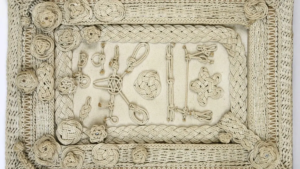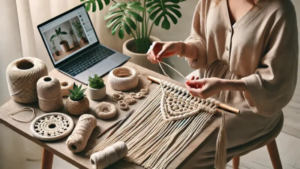Nothing breaks an artist’s heart quite like discovering damage to a beloved macrame masterpiece that took countless hours to create. Whether it’s a treasured wall hanging showing signs of wear, a favorite plant hanger with broken strands, or a family heirloom beginning to deteriorate, understanding cotton twine macrame repair techniques can transform heartbreak into hope and restore your precious handcrafted pieces to their former glory.
Professional restoration artists understand that proper repair methods not only fix visible damage but also strengthen vulnerable areas to prevent future deterioration. These comprehensive cotton twine macrame repair techniques combine traditional craftsmanship with modern preservation science, enabling you to breathe new life into damaged pieces while maintaining their original character and structural integrity.
Foundation Knowledge: Essential Cotton Twine Macrame Repair Techniques Assessment
Before attempting any restoration work, thorough damage assessment forms the cornerstone of successful cotton twine macrame repair techniques that preserve artistic integrity while addressing structural concerns. Professional conservators spend considerable time evaluating damage patterns, fiber condition, and structural stability before developing comprehensive repair strategies.
Begin damage assessment by examining the overall structural integrity of your macrame piece under good lighting conditions. Look for broken strands, loose knots, frayed areas, discoloration, and signs of pest damage that require immediate attention. Document findings with detailed photographs from multiple angles, creating a visual record that guides repair priorities and helps track restoration progress. These systematic cotton twine macrame repair techniques ensure nothing important gets overlooked during the restoration process.
Fiber condition evaluation determines whether cotton twine remains suitable for repair or requires complete replacement in damaged areas. Gently test fiber strength by applying light tension to suspicious areas, noting any brittleness, excessive stretching, or immediate breakage that indicates severe deterioration. Healthy cotton twine should feel supple and strong, while damaged fibers often appear discolored, feel rough or brittle, and break easily under minimal stress. Understanding these cotton twine macrame repair techniques assessment criteria helps determine appropriate restoration approaches.
Knot integrity analysis identifies loose connections, slipped knots, and areas where structural failure has occurred or might develop during repair work. Systematic examination of each knot reveals patterns of wear, stress concentration points, and areas requiring reinforcement during restoration. Professional cotton twine macrame repair techniques prioritize structural stability over cosmetic appearance, ensuring repairs maintain long-term durability rather than providing temporary fixes that fail quickly.
Basic Cotton Twine Macrame Repair Techniques: Simple Restoration Methods
Simple damage patterns often respond effectively to basic cotton twine macrame repair techniques that require minimal tools and materials while providing lasting solutions. These foundational repair methods address the most common problems encountered in cotton twine macrame pieces and serve as building blocks for more complex restoration procedures.
Frayed strand repair represents one of the most frequently needed cotton twine macrame repair techniques for pieces showing normal wear patterns. Carefully trim damaged fiber ends using sharp scissors, cutting at slight angles to prevent blunt edges that could catch on surrounding material. Remove only the minimum amount necessary to eliminate damage while preserving original length and proportions. Clean cuts heal better and integrate more seamlessly into existing structures than rough or uneven trimming attempts.
Loose knot retightening requires gentle manipulation that restores proper tension without over-stressing surrounding areas. Work systematically from the loosest point toward tighter sections, gradually increasing tension while monitoring for signs of fiber stress or breakage. Proper cotton twine macrame repair techniques maintain consistent tension throughout restored areas, preventing weak spots that could fail under normal use conditions. Always test knot security after tightening to ensure repairs will withstand typical handling and environmental stresses.
Surface cleaning often dramatically improves appearance while revealing hidden damage that requires attention during restoration work. Use soft-bristled brushes or low-suction vacuum attachments to remove accumulated dust and debris that masks underlying problems. Gentle cleaning cotton twine macrame repair techniques avoid mechanical damage while improving visibility for detailed repair work. Clean pieces also accept new materials better, creating stronger bonds between original and replacement fibers.
Advanced Cotton Twine Macrame Repair Techniques: Professional Restoration Methods
Complex damage patterns require sophisticated cotton twine macrame repair techniques that combine traditional craftsmanship skills with modern preservation science. Professional restoration methods address extensive deterioration while maintaining historical accuracy and artistic integrity throughout the repair process.
Strand replacement techniques enable restoration of severely damaged areas where original cotton twine cannot be salvaged through simple repair methods. Select replacement materials that match original fiber weight, twist direction, color, and texture as closely as possible to ensure seamless integration. Professional cotton twine macrame repair techniques source authentic materials from reputable suppliers who specialize in restoration-quality fibers designed for conservation applications.
Splicing methods create strong, nearly invisible connections between new and existing cotton twine sections that distribute stress loads effectively across multiple contact points. Traditional rope splicing techniques adapted for macrame applications create joints stronger than the original fiber while maintaining flexibility and appearance. Master these cotton twine macrame repair techniques through practice on sample materials before attempting repairs on valuable pieces.
Structural reinforcement addresses areas where repeated stress has weakened knot connections or created potential failure points that could compromise entire sections. Strategic addition of supporting elements distributes loads more evenly while maintaining original design aesthetics. Advanced cotton twine macrame repair techniques incorporate reinforcement methods that remain invisible while providing significant strength improvements.
Specialized Cotton Twine Macrame Repair Techniques: Challenging Damage Scenarios
Unique damage situations require specialized cotton twine macrame repair techniques that address specific problems not covered by standard restoration methods. These challenging scenarios often result from environmental exposure, pest damage, or accidents that create complex repair requirements.
Mold and mildew damage restoration requires careful assessment to determine whether affected areas can be salvaged or need complete replacement. Begin by isolating contaminated sections to prevent spread during handling, then evaluate fiber integrity after thorough cleaning with antifungal solutions designed for natural textiles. Professional cotton twine macrame repair techniques for biological contamination prioritize health safety while preserving as much original material as possible.
Chemical stain removal involves identifying contaminant types and selecting appropriate treatment methods that remove discoloration without damaging cotton fibers. Test cleaning solutions on hidden areas before treating visible surfaces, documenting results to guide treatment decisions. Specialized cotton twine macrame repair techniques for chemical damage often require multiple treatment cycles and patience to achieve optimal results without causing additional harm.
Pest damage restoration addresses holes, missing sections, and structural damage caused by insects feeding on cotton fibers. Assess the extent of damage carefully, as pest activity often continues longer than initially apparent, creating hidden weakness throughout affected pieces. Comprehensive cotton twine macrame repair techniques for pest damage include treatment to prevent re-infestation while rebuilding damaged structures using historically appropriate methods and materials.
Color Matching Cotton Twine Macrame Repair Techniques: Aesthetic Restoration
Achieving seamless color integration represents one of the most challenging aspects of cotton twine macrame repair techniques, requiring artistic skill combined with technical knowledge of natural fiber dyeing processes. Professional color matching ensures repairs remain virtually invisible while maintaining historical accuracy and aesthetic appeal.
Natural aging assessment helps determine original fiber colors before environmental exposure and use patterns created current appearances. Compare protected areas with exposed sections to understand natural color variation and aging patterns that guide restoration color choices. Effective cotton twine macrame repair techniques account for continued aging that will help new materials blend naturally over time.
Custom dyeing techniques create replacement materials that match existing colors precisely, accounting for variations in natural cotton fiber absorption and dye uptake patterns. Use traditional dyeing methods and materials when possible to ensure compatibility with original fibers and aging characteristics. Professional cotton twine macrame repair techniques often involve multiple dye baths and careful monitoring to achieve exact color matches.
Gradual color blending methods help new repair sections integrate seamlessly with surrounding original materials through strategic placement and careful attention to natural variation patterns. Professional cotton twine macrame repair techniques create transitions so subtle that repairs become virtually undetectable even under close examination. This artistry separates amateur repairs from professional restoration work.
Tool and Material Selection: Essential Cotton Twine Macrame Repair Techniques Equipment
Proper tools and materials form the foundation of successful cotton twine macrame repair techniques that produce lasting, professional-quality results. Professional conservators invest in high-quality equipment specifically designed for textile restoration work that provides precision control and consistent results.
Cutting tools require exceptional sharpness and precision to create clean edges that integrate seamlessly with existing materials. Invest in professional textile scissors, craft knives, and specialized cutting implements designed for natural fiber work. Sharp tools enable precise cotton twine macrame repair techniques while dull implements create rough edges that weaken repairs and appear obviously patched.
Joining materials must match original fiber characteristics while providing superior bonding strength for long-term durability. Select adhesives, threads, and reinforcement materials specifically designed for natural textile restoration that remain flexible while providing excellent adhesion. Professional cotton twine macrame repair techniques rely on proven materials with documented aging characteristics and compatibility with cotton fibers.
Measurement and documentation tools enable precise work planning and accurate restoration that maintains original proportions and design elements. Digital calipers, flexible measuring tapes, and photography equipment help document original conditions and monitor repair progress. Systematic cotton twine macrame repair techniques rely on accurate measurements and detailed documentation for consistent, professional results.
Working Environment Setup: Optimal Cotton Twine Macrame Repair Techniques Conditions
Creating appropriate working conditions dramatically improves cotton twine macrame repair techniques success rates while protecting both original pieces and repair materials from environmental contamination or damage during restoration work. Professional conservators maintain controlled environments specifically designed for delicate textile restoration.
Lighting requirements include bright, color-balanced illumination that reveals fine details without generating excessive heat that could damage sensitive cotton fibers. LED lighting systems provide excellent visibility while remaining cool enough for extended use near delicate materials. Proper lighting enables precise cotton twine macrame repair techniques while preventing eye strain during detailed restoration work.
Work surface preparation involves creating clean, stable platforms that support macrame pieces properly while providing easy access for repair operations. Padded surfaces prevent pressure damage while smooth finishes avoid snagging delicate fibers during manipulation. Well-designed work areas facilitate efficient cotton twine macrame repair techniques while protecting pieces from accidental damage.
Environmental control maintains optimal temperature and humidity levels that keep cotton fibers in proper condition for repair work while preventing additional deterioration during restoration procedures. Controlled conditions enable cotton twine macrame repair techniques to proceed without rushing due to changing environmental factors that could compromise repair quality or piece integrity.
Documentation Methods: Recording Cotton Twine macrame Repair Techniques Progress
Thorough documentation serves multiple purposes in professional cotton twine macrame repair techniques, creating permanent records that guide current work while providing valuable information for future conservation efforts. Systematic record-keeping distinguishes professional restoration from amateur repair attempts.
Before-and-after photography captures condition details that guide repair decisions while documenting restoration success for insurance, appraisal, or historical purposes. Use consistent lighting, backgrounds, and camera angles to create comparable images throughout the restoration process. Professional cotton twine macrame repair techniques always include comprehensive photographic documentation that tells the complete restoration story.
Written records detail materials used, techniques employed, and decision-making processes that guided restoration choices. Include supplier information for replacement materials, mixing ratios for custom dyes, and time investments for different repair procedures. Detailed cotton twine macrame repair techniques documentation enables future conservators to understand previous work and make informed decisions about additional treatments.
Condition monitoring establishes baseline measurements and ongoing assessment protocols that track restoration success over time. Document fiber strength, color stability, and structural integrity measurements that enable early detection of problems requiring attention. Systematic cotton twine macrame repair techniques monitoring prevents minor issues from developing into major problems requiring extensive re-restoration.
Quality Control Standards: Professional Cotton Twine Macrame Repair Techniques Verification
Implementing rigorous quality control measures ensures cotton twine macrame repair techniques produce lasting results that meet professional conservation standards. Systematic verification procedures catch potential problems before they compromise restoration success or piece integrity.
Strength testing verifies that repaired areas can withstand normal handling and environmental stresses without failing prematurely. Gentle stress testing of repair joints and reinforced areas confirms adequate bonding while identifying areas requiring additional attention. Professional cotton twine macrame repair techniques always include strength verification as part of quality assurance protocols.
Appearance evaluation assesses visual integration of repair areas with surrounding original materials under various lighting conditions. Examine repairs from multiple angles and distances to ensure seamless blending that maintains aesthetic integrity. Successful cotton twine macrame repair techniques create restorations virtually indistinguishable from original construction when viewed under normal conditions.
Longevity assessment considers factors that might affect repair durability over extended periods, including material compatibility, environmental stability, and stress distribution patterns. Project realistic service life expectations based on materials used and repair methods employed. Honest cotton twine macrame repair techniques evaluation helps set appropriate expectations while identifying maintenance requirements for optimal long-term performance.

Large Nordic Bohemian for Macrame Wall Hanging
Elevate your home decor with the stunning Large Nordic Bohemian Macrame Wall Hanging, a perfect blend of Scandinavian minimalism and bohemian flair. This handwoven tapestry is an exquisite piece of art that adds warmth, texture, and style to any room, making it an ideal choice for those looking to create a cozy and chic atmosphere.
Frequently Asked Questions
What tools are absolutely essential for successful cotton twine macrame repair techniques?
Professional-quality textile scissors represent the most critical tool investment, enabling clean cuts that integrate seamlessly with existing materials. Additionally, you’ll need sharp craft knives for precision work, flexible measuring tools for accurate sizing, good lighting for detail visibility, and magnification for examining fiber conditions. Quality tools make cotton twine macrame repair techniques significantly more successful while preventing accidental damage during restoration work.
How can I determine if my damaged macrame piece is worth repairing using cotton twine macrame repair techniques?
Consider both sentimental and monetary value when evaluating repair worthiness, as emotional attachment often justifies restoration costs that exceed replacement values. Assess damage extent, structural integrity, and availability of matching materials before committing to restoration efforts. Generally, pieces with intact structural elements and localized damage respond well to cotton twine macrame repair techniques, while extensively deteriorated items may require complete reconstruction that exceeds restoration benefits.
Can I successfully apply cotton twine macrame repair techniques without professional training?
Basic repairs like trimming frayed ends, retightening loose knots, and simple cleaning can be safely attempted by careful beginners following proper techniques. However, complex structural repairs, color matching, and valuable piece restoration require professional expertise to avoid causing additional damage. Start with practice pieces to develop cotton twine macrame repair techniques skills before attempting repairs on important or valuable macrame items.
How long do repairs typically last when proper cotton twine macrame repair techniques are used?
Well-executed repairs using appropriate materials and techniques often outlast surrounding original materials, particularly when environmental conditions remain favorable for natural fiber preservation. Quality repairs can provide decades of additional service life while maintaining structural integrity and aesthetic appeal. The longevity of cotton twine macrame repair techniques depends heavily on material quality, repair execution, and ongoing maintenance practices that support long-term preservation.
Conclusion
Mastering cotton twine macrame repair techniques empowers you to preserve cherished handcrafted pieces while developing valuable skills that honor traditional craftsmanship and modern conservation science. Through careful assessment, proper tool selection, systematic repair procedures, and quality verification, you can restore damaged macrame pieces to functional beauty that serves for generations.
The journey from damaged piece to restored masterpiece requires patience, practice, and respect for the original artist’s vision while adding your own conservation expertise to extend the piece’s useful life. Whether addressing simple fraying or complex structural damage, these comprehensive cotton twine macrame repair techniques provide the foundation for successful restoration that maintains both aesthetic appeal and structural integrity.
Remember that each restoration project teaches valuable lessons that improve future cotton twine macrame repair techniques while building expertise that benefits your entire collection. The investment in proper materials, tools, and techniques pays dividends through successful restorations that preserve artistic heritage while providing personal satisfaction that comes from breathing new life into treasured handcrafted pieces.









